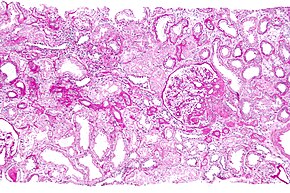| Renal biopsy | |
|---|---|
 Micrograph showing a renal core biopsy. PAS stain. | |
| ICD-9-CM | 55.23-55.24 |
| MedlinePlus | 003907 |
Renal biopsy (also kidney biopsy) is a medical procedure in which a small piece of kidney is removed from the body for examination, usually under a microscope.[1] Microscopic examination of the tissue can provide information needed to diagnose, monitor or treat problems of the kidney.
A renal biopsy can be targeted to a particular lesion, for example a tumour arising from the kidney (targeted renal biopsy). More commonly, however, the biopsy is non-targeted as medical conditions affecting the kidney typically involve all kidney tissue indiscriminately. In the latter situation, any sufficiently sized piece of kidney tissue can be used.[citation needed]
A native renal biopsy is one in which the patient's own kidneys are biopsied. In a transplant renal biopsy, the kidney of another person that has been transplanted into the patient is biopsied. Transplant kidney biopsy can be performed when nothing is apparently wrong with the transplant kidney for the purposes of surveillance for hidden disease (protocol transplant biopsy). This is typically done at 0, 3 and 12 months post-transplant according to a transplant unit protocol. Biopsy of the transplanted kidney taken during the transplant operation is termed implantation transplant biopsy or post-perfusion transplant biopsy depending on the timing of the biopsy with respect to key stages of the operation. When the transplanted kidney is not working properly, biopsy may be undertaken to identify the cause of dysfunction. This is referred to as an indication transplant biopsy, because something has prompted the performance of the biopsy.
Renal biopsy may be performed with the aid of "real-time" medical imaging to guide the positioning of biopsy equipment (imaging-guided renal biopsy). Alternatively, a biopsy may be performed without imaging-guidance using indirect assessments of position such as "needle-swing" to confirm appropriate placement of biopsy equipment (blind renal biopsy).
- ^ Young, Michael; Leslie, Stephen (2022), "Renal Biopsy", StatPearls, Treasure Island (FL): StatPearls Publishing, PMID 29262196, retrieved 2023-11-24